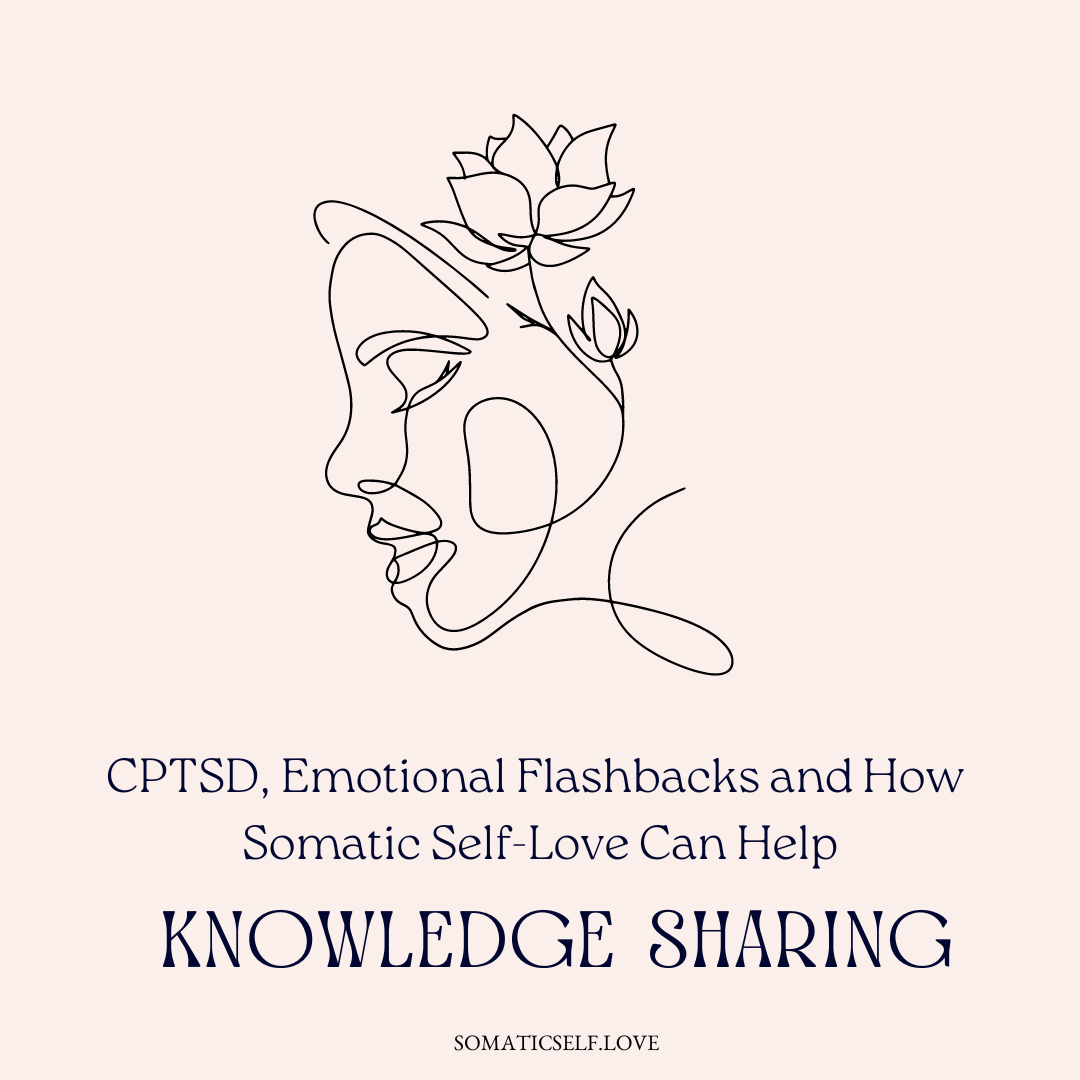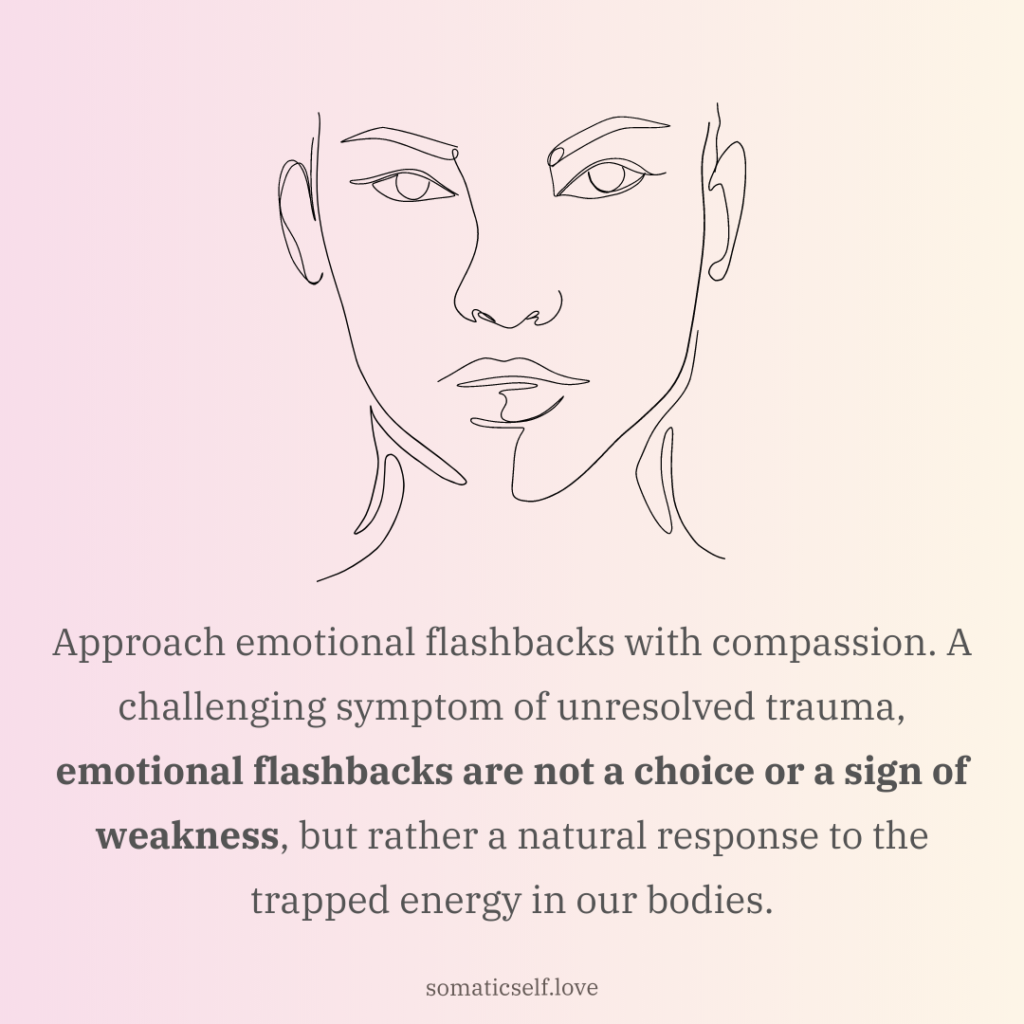CPTSD, Emotional Flashbacks and How Somatic Self-Love Can Help

Discover how somatic self-love can help provide relief from emotional flashbacks associated with CPTSD, and learn how to begin your journey towards recovery and thriving.
What is CPTSD?
CPTSD (Complex Post-Traumatic Stress Disorder) is a condition that can result from prolonged exposure to traumatic experiences, such as abuse or neglect. One of the key symptoms of CPTSD is emotional flashbacks, which involve feeling intense emotions that are related to past traumatic experiences.
What is an Emotional Flashback?
Emotional flashbacks can be triggered by a variety of stimuli, and can be difficult to manage without proper support.
The term “emotional flashback” was coined by Pete Walker, a licensed psychotherapist and author who specializes in working with individuals who have experienced childhood trauma. In his book “Complex PTSD: From Surviving to Thriving,” Walker describes emotional flashbacks as a type of re-experiencing of past trauma on an emotional level, rather than a visual or sensory level. He notes that emotional flashbacks can be triggered by a wide range of events or situations and can be difficult to recognize and manage without proper support and treatment. Since the publication of his book, the term “emotional flashback” has become increasingly recognized and used in the field of trauma therapy.

During an emotional flashback, we may feel overwhelmed by intense emotions such as fear, shame, anger, or helplessness. These emotions can be triggered by seemingly unrelated events, such as a loud noise, a particular smell, or a certain tone of voice. Emotional flashbacks can be difficult to recognize, as they often feel like a sudden and overwhelming surge of emotion without a clear trigger.
Emotional flashbacks are thought to be caused by the brain’s inability to properly process traumatic experiences. When someone experiences a traumatic event, the brain’s natural coping mechanisms may be overwhelmed, leading to a state of heightened arousal and hypervigilance. This state can become chronic and lead to emotional flashbacks, where the individual feels as if they are reliving the traumatic event on an emotional level.
Some common symptoms of emotional flashbacks include:
- Intense feelings of fear, shame, or helplessness
- Feeling disconnected from one’s body or surroundings
- Difficulty with emotional regulation
- Negative self-talk or inner critical voice
- Difficulty with concentration or memory
- Feeling overwhelmed and unable to cope
It’s important to have compassion as we unravel the complexities of emotional flashbacks.
It’s important to approach the experience of emotional flashbacks with compassion and understanding, as they can be a challenging and distressing symptom of unresolved trauma. Emotional flashbacks are not a choice or a sign of weakness, but rather a natural response to the trapped energy in our bodies.
When we experience emotional flashbacks, we may feel overwhelmed, ashamed, or embarrassed by the symptoms, and may struggle to understand their experiences. It’s important for friends, family members, and mental health professionals to provide support and understanding, and to help us to develop coping strategies for managing symptoms.
It’s also important to recognize that recovering from trauma is a complex and ongoing process, and that there may be setbacks and challenges along the way. It’s important to approach this process with patience and self-compassion, and to recognize that healing is possible with the right support and resources.
There Is Hope and Help to Grow and Thrive!
Somatic self-love can be a powerful tool for managing emotional flashbacks related to CPTSD. Here’s how:
- Grounding: Somatic self-love practices can help to ground us in the present moment, which can be especially important when experiencing an emotional flashback. Focusing on our body and our breath helps calm our nervous system and reduce feelings of anxiety or distress.
- Self-compassion: Somatic self-love practices emphasize self-compassion and self-acceptance, which can be a powerful antidote to the shame and self-blame that often accompany emotional flashbacks. By cultivating a greater sense of self-love and acceptance, we reduce the intensity of emotional reactions and promote a greater sense of calm and well-being.
- Releasing tension: Somatic self-love practices release tension and get our emotions, which may be stored unknowingly in our bodies, flowing again. Engaging in yoga, meditation, or deep breathing, we gently release the physical and emotional tension that often accompanies emotional flashbacks.
- Mind-body connection: Somatic self-love practices deepen our mind-body connection, which is a powerful tool for managing emotional flashbacks. By focusing on our body and breath, we cultivate a greater sense of self-awareness and presence, which helps to reduce the intensity of our emotional reactions.
Overall, somatic self-love practices can be a powerful tool for managing emotional flashbacks related to CPTSD. We promote recovery and growth by grounding in the present moment, cultivating self-compassion, releasing tension, and deepening the mind-body connection.
If you are struggling with emotional flashbacks or other symptoms of CPTSD, it is important to seek support from a qualified mental health professional who can help you to develop a comprehensive treatment plan.
Somatic Self-Love Ritual for Present Moment Awareness
Here is a somatic self-love ritual that can help with CPTSD emotional flashbacks by promoting present moment awareness:
- Find a quiet and comfortable space: Find a quiet and comfortable space where you won’t be interrupted. You might want to light some candles or incense to create a calming atmosphere.
- Get grounded: Sit or lie down in a comfortable position and close your eyes. Take a few deep breaths, and focus on the sensation of your breath moving in and out of your body. Feel your body sinking into the surface beneath you, and imagine roots extending from your body into the ground, anchoring you in the present moment.
- Tune into your senses: Tune into your senses by focusing on what you can hear, see, smell, taste, and touch. Try to identify five things you can see, four things you can hear, three things you can touch, two things you can smell, and one thing you can taste. This exercise can help to bring you into the present moment and reduce the intensity of an emotional flashback.
- Practice deep breathing: Take a few deep breaths, focusing on the sensation of your breath moving in and out of your body. You might want to try the 4-7-8 breathing technique: inhale for a count of four, hold your breath for a count of seven, and exhale for a count of eight. This technique can help to calm your nervous system and reduce feelings of anxiety or distress.
- Use positive affirmations: Use positive affirmations to cultivate a greater sense of self-love and self-acceptance. You might want to repeat affirmations such as “I am worthy of love and acceptance,” or “I am strong and capable of overcoming any challenge.” These affirmations can help to counteract the negative self-talk and self-blame that often accompany emotional flashbacks.
- Practice gratitude: Practice gratitude by reflecting on the things in your life that bring you joy and happiness. You might want to write down three things you are grateful for each day, or simply take a few moments to reflect on the positive things in your life. This practice can help to promote a positive mindset and a greater sense of well-being.
Overall, this somatic self-love ritual can help to promote present moment awareness and reduce the intensity of CPTSD emotional flashbacks. By grounding yourself in the present moment, tuning into your senses, practicing deep breathing, using positive affirmations, and practicing gratitude, you can cultivate a greater sense of self-love and self-acceptance, and promote healing and growth in your life.